9 Examples of Author Bios and Bylines to Get You Started

A huge part of the point of blogging today is not about the traffic to your website or the way the blog converts users into customers but about the way it builds you up as an authority and leader in your industry. It's called thought leadership, and it's all about building up your network, recognition of who you are and what you've accomplished, and most importantly, the expertise stored away in that brain of yours.
You can't build thought leadership without attaching your name to your content. It's not enough to run a blog and have an author About page; it's not visible and not tangibly attached. No, what you need is an author bio and byline.
A bio and byline box also give you something you can hand to other bloggers when you guest post, so you can spread that information around.
We know this is important for more than just external and nebulous leadership factors, as well. Everything from Google's short-lived attempt to push Authorship to Google's current initiatives promoting EEAT (Expertise, Experience, Authoritativeness, and Trustworthiness) all point to the same general goal:
This cuts both ways. Publishing great content with your name attached is a wonderful way to build up your expertise. Meanwhile, it discourages publishing bad or outright wrong content because you're putting your real name on it, and that will reflect upon you in the future.
Now, whether or not that's actually a disincentive is a whole other discussion, one that AI is muddling and that the ease of creating a fake persona doesn't help. But that's beyond the scope of today's post.
If you want a deeper discussion into the whys and wherefores of author bios, I wrote that over here. Today, I'm going to give you tangible examples of author bios and what they're doing right so you can replicate them.
 30 Second Summary
30 Second Summary
You need to build up your industry authority with thought leadership, and that starts with a strong author bio. You should always attach your name to your content with more than just a basic byline. Your author bio must include your professional achievements, a personal touch about who you are and ways to connect with you. You should also add a high-quality photo and social media links. You'll want to write it in third person and keep it clear and direct.
Example 1: Neil Patel
Like him or not, enjoy his content or not, believe what he says or not, there's one thing that's undeniable about Neil, and that's that he knows how to brand himself. Everything he does is about pushing his branding and his own personal authority. He can't produce a single piece of content without at least seven pictures of himself in it, and he's instantly recognizable throughout the entire industry.
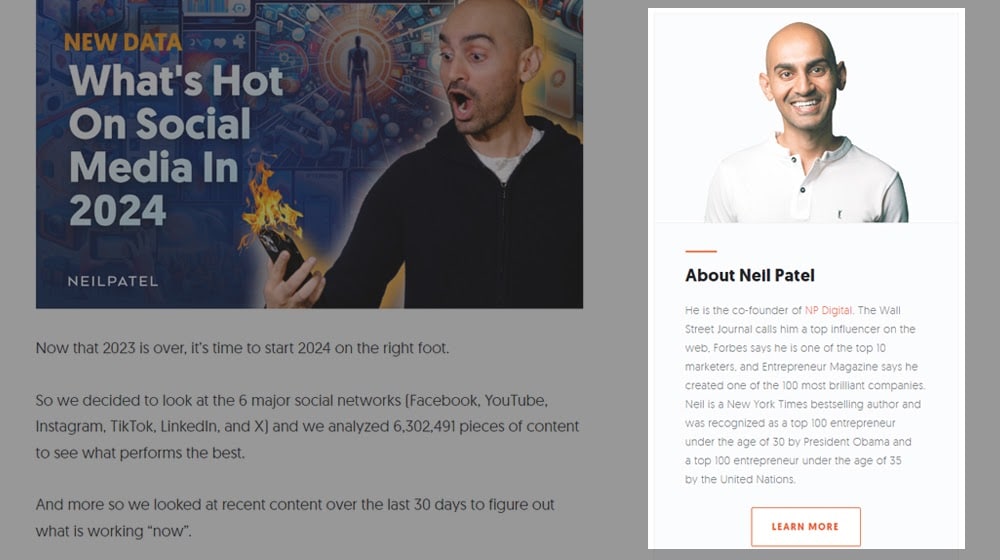
What about his author bio, though? Unusually, for most blogs, it's in a sidebar rather than the footer, but it's still undeniably an author bio. It also follows the key points that you want in an author bio.
- It's in the third person.
- It puffs him up with a list of accolades.
- It offers ways to learn more about him and what he does.
- It has a good photo (of course.)
If I had a gripe about his bio, it's that there's nothing to it beyond being a trophy case for his accolades. What kind of person is he? What does he like to do? What are his social media links? You don't get answers to these questions.
Example 2: Matt G. Southern
This is both a decent example and a terrible example.
Matt's bio is pretty simple, all things considered. It tells you who he is, what his role is within Search Engine Journal, and what he specializes in doing in his content. It's all very basic. His actual profile page has links to his social networks, but the bio does not. His picture is fine; no problems there.
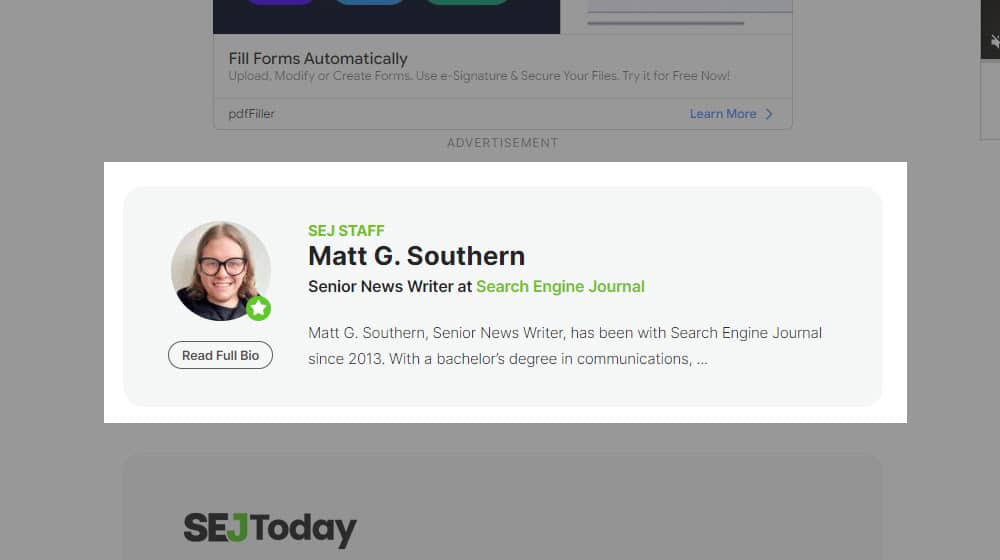
The reason I flag this as a bad example is the actual linked post above. When you scroll down to the author bio, what do you see? His picture, his name, his role, and not much else. In fact, over half of his actual bio is truncated. Even if his bio was great, to have more than half of it cut off and not displayed is a travesty.
Admittedly, this is more of a failing with SEJ than it is with the author. Heck, back when I wrote for SEJ, I even kept my bio extra short, and even that ended up truncated. There's just no space here for what really matters for E-A-T these days.
Example 3: Despina Gavoyannis
Ahrefs is an example of a fantastic multi-author blog that doesn't really give its authors enough credit, in my opinion. I mean, I've been reading their blog, citing it repeatedly, and learning a lot from it for over a decade, and I couldn't really name you any of their authors offhand. They have bylines and bios, but it's kind of inconsistent; sometimes they're in a sidebar and sometimes a footer, sometimes they're longer and sometimes shorter, and they aren't given a ton of room to breathe.
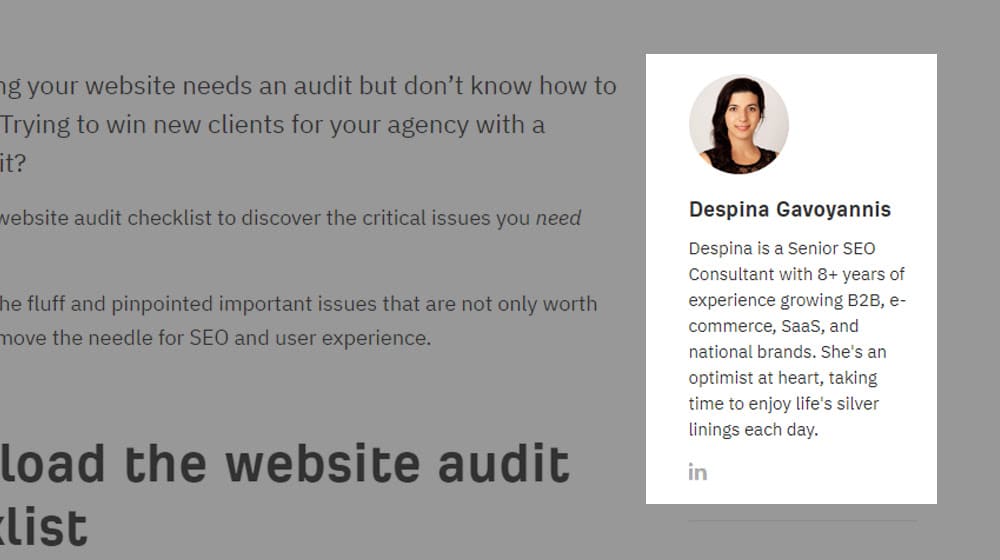
Despina's bio here makes the best use of that limited space. She has a picture and a LinkedIn link, but the true value here is how she makes use of the space she's given. She barely has more space than SEJ's example above, but she manages to promote both her professional statistics and a bit of personal outlook in that space. It tells you what her accolades are, but also a bit of who she is, which is (in my opinion) a critical aspect of an author bio that many people lack.
Example 4: Christopher Lara
This is another example of a pretty good author bio that has a couple of flaws I would personally see addressed if it were my own. First, the good; it has accolades and experience, it has a way to contact him, and it even has a hint at location for a bit of local SEO flavoring. The social media links are understated but available.
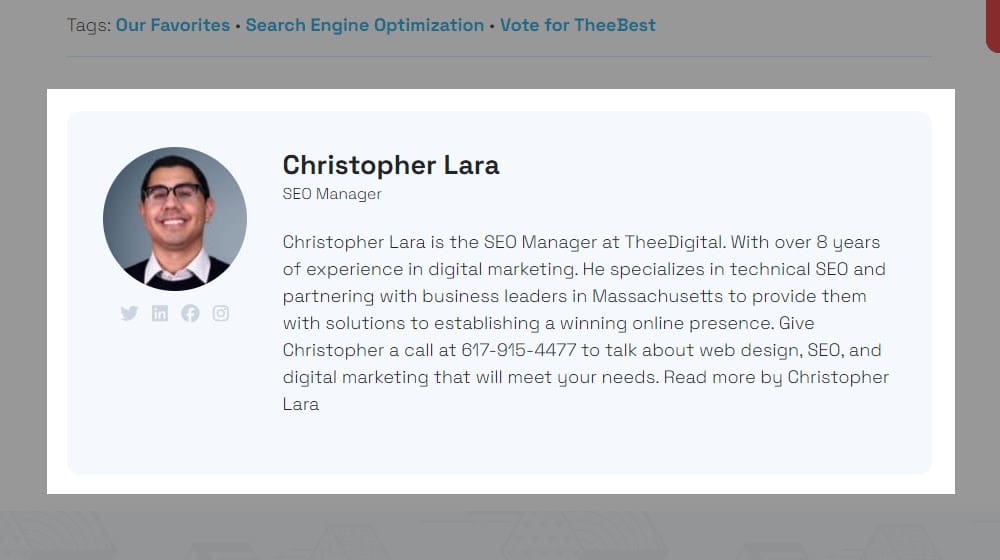
On the other hand, it doesn't have much personality to it. Also, his picture is blurry and low-res, even in a small avatar size. I'm also not a fan of how the read more link at the end of the bio doesn't link the actual "read more" portion of the text and doesn't visibly look like a link, but that's a website style issue and not a composition issue.
Example 5: Alex Moran
This is a pretty decent example of a basic byline and should be essentially the bare minimum of a bio you put on any site you write for. It has a list of his accolades and experience, his specialties, and a few namedrops of bigger clients he's worked with in the past. Who wouldn't want to trust advice from someone experienced enough to work with Nestle and PayPal? He also has a good link to his personal brand's website.
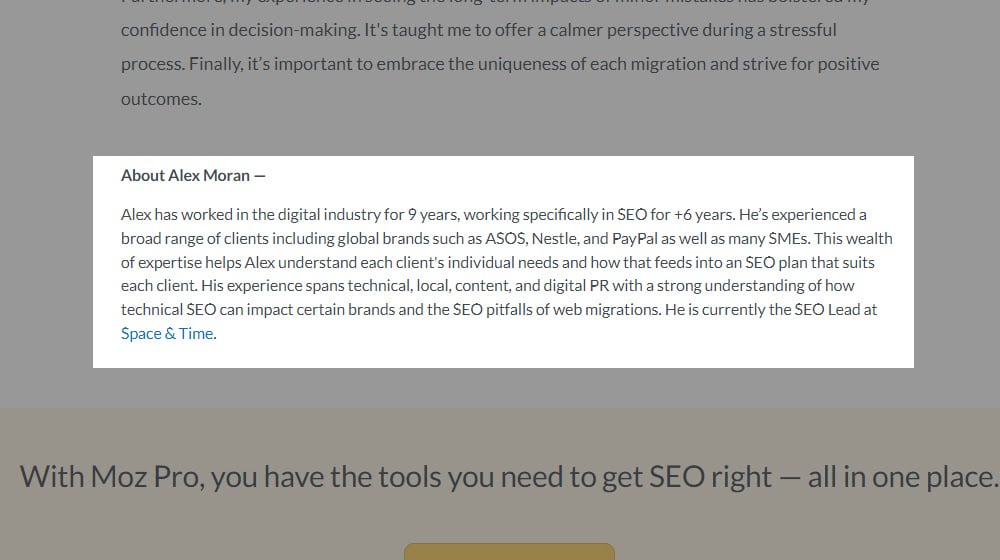
You can already guess the downsides. Despite having plenty of space, there's nothing personal or interesting about his bio. People working in SEO for a decade are a dime a dozen, and big clients churn through large teams of marketers annually. He has a good content focus in his bio, but nothing to tell me who he really is. There's also no picture in this bio, though he does get one at the top and in the blog index, so it's not entirely missing.
Example 6: Becky Simms
Bright, happy, vibrant profile picture: check. Social media links: check. Unique accolades: check. Personal touch and perspective: check. This is an excellent example of an author bio done right, with one very tiny exception. Can you spot it?
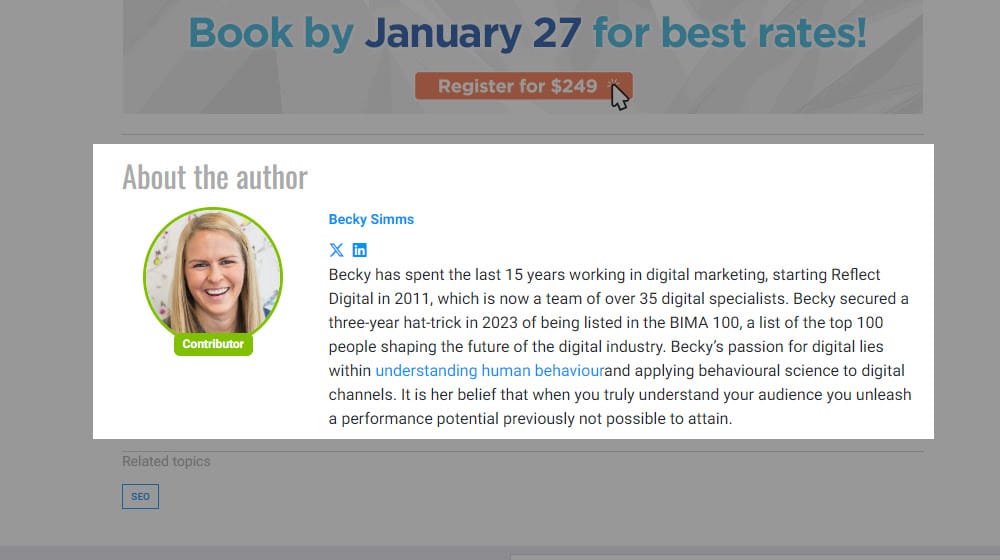
It's the link. The link itself isn't bad; it's her company and a page relevant to specifically what she's talking about, tying her overall perspective into her company's mission and focus. But it's not immediately obvious that the link goes to a company page or that it's her company (though you can make that assumption.)
That, and there's a missing space between the end of the link and the start of the next word. Tiny, I know, but the details do matter! If the bio isn't proofread in place, are there other details she misses?
Example 7: Tushar Pol
This is another middle-of-the-road author bio. It tells you who he is and where his expertise lies, it has a social media link, and it has a photo. It's serviceable.
My gripe with this is actually about the personalization and the disconnect it expresses between the first sentence and the last. It says he has four years of experience in SEO. Fine, that's great! You can learn a lot in four years. But at the end, it says his goal is to "turn Semrush blog into the ultimate destination for learning SEO and web marketing."

First of all, Semrush is already one of the biggest names in SEO and marketing. Secondly, I don't think someone with four years of experience is going to be the one pushing that envelope compared to many much more commonplace names and longer-term career marketers.
Don't get me wrong; maybe he can do it. Maybe he's an SEO genius and can kick Semrush into an even higher tier of household name. Truthfully, though, it comes across as a little like trying to fill shoes that are a bit too big.
Example 8: Marieke van de Rakt
This is a weird example. Yoast doesn't put author names by posts in their blog index, but they do include a bio box at the bottom. Marieke's is particularly interesting because she was the CEO of Yoast for a long time. She wrote a lot of their content, and arguably, she built them into the success they are today.

This author bio is pretty minimal, all things considered. It doesn't have a link to a more thorough profile page for her, nor does it have any links at all. There are no social media links, no link to her current business, and no mention of where she went when she left the company.
The weirdness to me isn't any of that, but it's the fact that they call out that she's no longer with the company at all. They didn't have to do that, nor did they have to phrase it in a way that almost feels aggressive. It makes me wonder if they parted on bad terms. She didn't – they just left when they sold Yoast – but it's still a little weird.
Example 9: Brian Dean
Here's an interesting one. Brian Dean doesn't really have a byline. His name is attached to the top of the post, but he mostly just relies on the fact that he's already a household name in SEO to carry weight. Everyone who spends any time in marketing knows who Brian is and knows Backlinko is his site.
My worry here is that the fact that his blog posts don't have a bio box – and that his About page is more of a sales landing page than an actual About page – encourages bad habits in people who mimic him without knowing what they're doing and why.
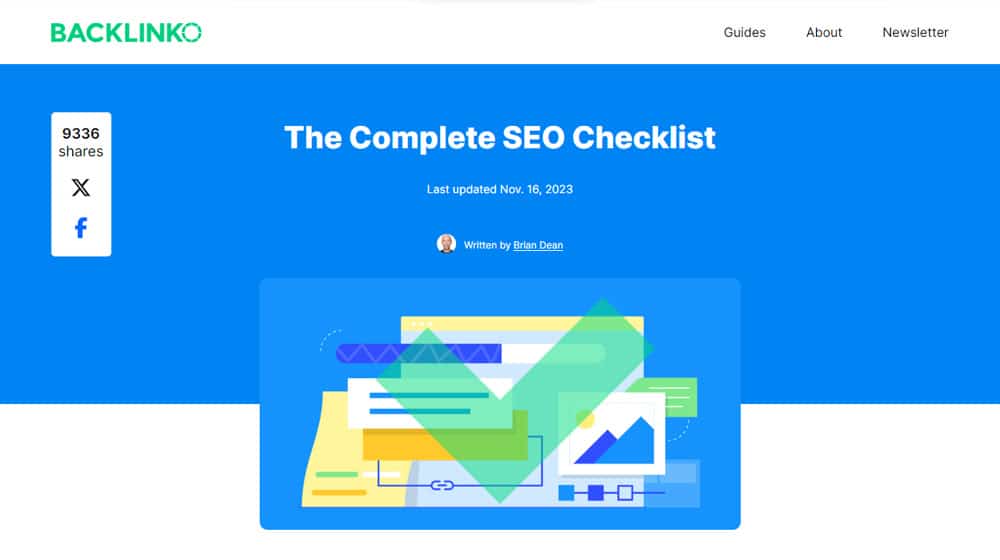
It gets worse. When you browse his blog, check out posts written by other authors. For example, here's one by Leigh McKenzie, a collaboration with Semrush. Who is Leigh? I have no idea. There's no author bio box, the byline is tiny and has no links – even to Semrush itself – and even the author image is minuscule enough you can't see any details.
And that's not even considering all the posts on Backlinko published under "Backlinko Team" rather than any real person's name.
Don't get me wrong, Brian, you're a fantastic marketer, and your advice is top-notch. This is just a prime example of how, when you get big enough, you no longer have to care about minor details the rest of us need to pay attention to if we want to achieve the same success.
I guess; thanks for leaving room for the rest of us to catch up.
So, what can you learn from all of these examples?
Basically, a lot of people either don't know how to write bios, don't know how to properly format them for their websites, or simply don't care as much about them as they should.

Personally, I think author bio boxes should be given much more attention in the modern era of E-A-T and, more importantly, the current death of authority we're seeing happen because of AI-generated content. If you want to promote humans writing your content, you need a good, strong author bio. Otherwise, what kind of trust and authority are you building?



 30 Second Summary
30 Second Summary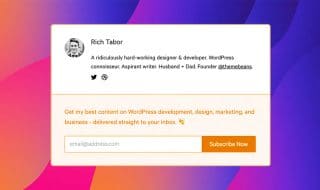



January 22, 2024
Thanks for sharing your tips and feedback. I had the team update my bio photo to be higher resolution and made sure that the links visibly look like a link. Cheers!
January 30, 2024
Nice Christopher! Looks great. You're very welcome!